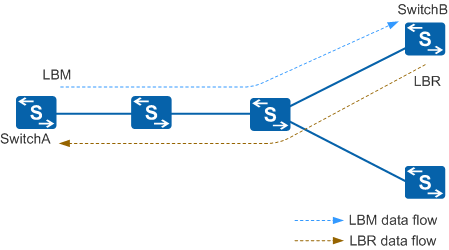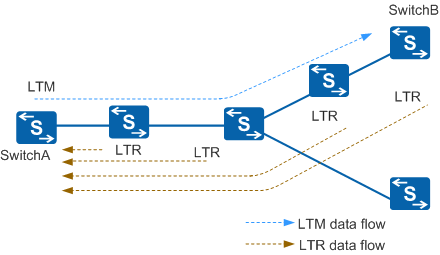CFM Enhancements
In addition to CFM loopback and linktrace in MDs, Huawei devices support generic MAC (GMAC) ping and trace on Layer 2 networks. Network administrators can use GMAC ping and trace functions to detect Layer 2 network faults without configuring CFM.
GMAC Ping
Figure 1 shows the implementation of GMAC ping on a simple network. GMAC ping works in the same manner as 802.1ag MAC ping. However, GMAC ping does not require a MEP to initiate it, and the destination node does not have to be a MEP or MIP. You can perform GMAC ping without configuring the MD, MA, or MEP on the source device, intermediate device, or destination device. You need to enable the GMAC function only on the intermediate device. GMAC ping is used on a network or part of a network without reference to MD, MA, or MEP configurations. The following example illustrates the GMAC ping process:
SwitchA sends an LBM to SwitchB. The LBM carries the MAC address of SwitchB and an ID of a virtual local area network (VLAN).
After receiving the LBM, SwitchB replies with an LBR. After receiving the LBR, SwitchA analyzes network performance by calculating the difference between the time the request was sent and the time the response was received.
GMAC Trace
Figure 2 shows the implementation of GMAC trace on a simple network. GMAC trace works in the same manner as 802.1ag MAC trace. However, GMAC trace does not require a MEP to initiate it, and the destination node does not have to be a MEP or MIP. GMAC trace can be implemented without configuring the MD, MA, or MEP on the source device, intermediate device, or destination device. All intermediate devices can respond with an LTR.
GMAC trace is used on a network or part of a network without reference to MD, MA, or MEP configurations. The following example illustrates the generic MAC trace process:
SwitchA sends an LTM to SwitchB. The LTM carries the MAC address of SwitchB and an ID of a VLAN.
After the LTM arrives at a device within the VLAN, the device reduces the TTL in the LTM by 1. If the TTL is not zero, the device then forwards the LTM. If the TTL is zero, the device drops the LTM.
- Each intermediate device replies by sending an LTR to SwitchA. After receiving the LTM, SwitchB also replies with an LTR and does not forward the LTM.
The LTRs sent to SwitchA from SwitchB and the intermediate devices provide SwitchA with information about the forwarding path between SwitchA and SwitchB.

